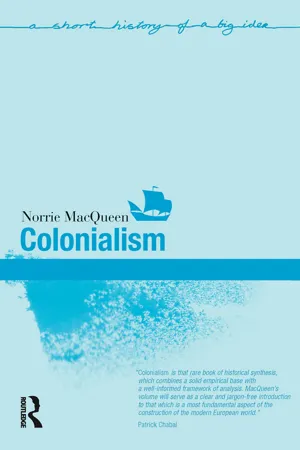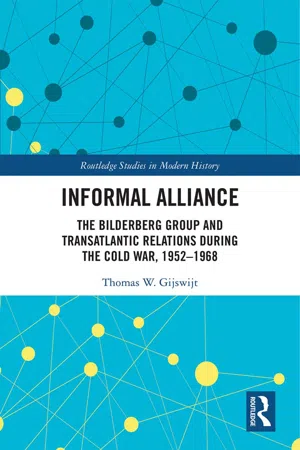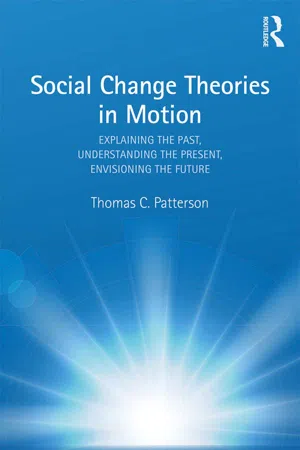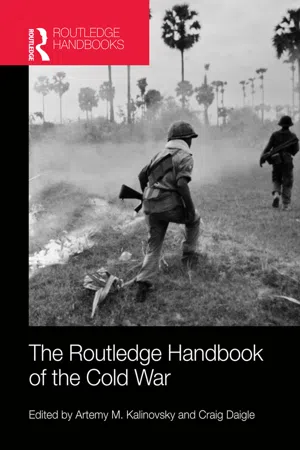History
The Cold War and Decolonization
The Cold War and decolonization refers to the period following World War II when the United States and the Soviet Union emerged as superpowers and engaged in a global struggle for influence. Simultaneously, many former colonies in Asia, Africa, and the Middle East gained independence from European colonial powers. This era was characterized by ideological competition, proxy wars, and the dismantling of colonial empires.
Written by Perlego with AI-assistance
Related key terms
7 Key excerpts on "The Cold War and Decolonization"
- eBook - ePub
- Norrie Macqueen(Author)
- 2014(Publication Date)
- Routledge(Publisher)
CHAPTER 6Decolonization and neocolonialism
WHEN HISTORIANS IN THE FUTURE come to consider the shaping forces of world politics in the second half of the twentieth century, it is a reasonable bet that decolonization will have a much more prominent place than the cold war. Already in the first decade of the twenty-first century this is probably a less controversial prediction than it would have been even a few years ago. Yet, for half a century after 1945 the strategic and ideological competition between east and west was deemed to be the phenomenon that shaped the age. This was understandable when the nuclear wherewithal behind the confrontation between east and west could destroy the planet several times over. A miscalculation in the superpower relationship could indeed be the end of the world. But later a different perspective began to form. Nuclear armageddon had not happened, and the easing of the threat to human existence allowed cooler judgements to be made. Moreover, the fixation on the cold war had obviously been strongest at the centre of the east-west relationship but the intellectual balance of power in the world began to shift as the twentieth century drew to a close. The historical concerns of those parts of the world for which the cold war was happening ‘elsewhere’ were gradually given more attention. These concerns were less with the distant prospect of nuclear annihilation than with the immediate realities of under-development.Although cold war bipolarity profoundly affected the shape of the international system at a particular time, it did not have anything like the impact of decolonization on its basic fabric. During the three decades after 1945 the tally of independent states in the world grew by a factor of three. As a result, the nature and conduct of international relations changed more in a few years than it had in centuries. The mind-maps of the peoples of both the ex-colonial powers and the former subject territories were fundamentally re-drawn. Quite simply, decolonization created a wholly new conception of the political world and everyone’s place within it. How far beyond the political – into areas of economic relations and cultural identities – this new conception extended is a question that takes us into more contested areas of debate. - eBook - ePub
Informal Alliance
The Bilderberg Group and Transatlantic Relations during the Cold War, 1952-1968
- Thomas W. Gijswijt(Author)
- 2018(Publication Date)
- Routledge(Publisher)
6 Decolonization and the global Cold WarThroughout the 1950s and 1960s, the so-called Third World appeared frequently on the agenda of the Bilderberg meetings. Most Bilderberg participants agreed that the global Cold War could well be decided there: if the West ‘lost’ major parts of the newly independent nations to communist expansion, the economic and political consequences could be dramatic.1 However, given the overwhelming speed of decolonization – in the first decade of its existence the United Nations admitted Thailand, Pakistan, Burma, Indonesia, Cambodia, Ceylon, Laos, Morocco, Sudan, and Tunisia as new members – and the divergent views on the timing and methods of dismantling Europe’s colonial territories, it proved impossible to forge a common transatlantic strategy with regard to the Third World. As Dean Rusk put it at the 1955 Barbizon Conference:The United States is caught in the middle between nationalist movements in other parts of the world and our friends in Europe. I can only say that there are no more excruciating problems for those who make policy than those arising out of colonial questions.2As this chapter shows, the Bilderberg discussions on decolonization did provide a much-needed forum to air grievances and to draw attention to the difficult political implications of the colonial question in most NATO countries. The Suez crisis was the most dramatic expression of transatlantic differences and led to much soul-searching at the 1957 Bilderberg conference in the United States. In terms of practical solutions to the challenge of decolonization, the Bilderberg discussions focused strongly on economic development and technical assistance. This was important because many Bilderberg participants and members, from World Bank President Eugene Black to Eisenhower speechwriter C. D. Jackson, were engaged in private and public initiatives focused on development of the ‘underdeveloped world.’ - eBook - ePub
- Marc Frey, Ronald W. Pruessen, Tai Yong Tan, Tan Tai Yong(Authors)
- 2015(Publication Date)
- Routledge(Publisher)
13 The United States and Southeast Asia in an Era of Decolonization, 1945–1965 Robert J. McMahonThe end of the imperial era and the concomitant rise of the so-called Third World unquestionably rank among the central, defining features of modern world history. In no corner of the globe, of course, did the twin processes of decolonization and national and regional transformation proceed with greater violence, turmoil, and upheaval than in Southeast Asia. These processes both shaped and were in turn shaped by another of the modern epoch’s central, defining features: the geopolitical and ideological battle for global power and influence waged between the United States and the Soviet Union. The so-called Cold War not only coincided temporally with the epic struggles for freedom that erupted across the Third World in the wake of World War II, but inevitably shaped the temper, pace, and ultimate outcome of those struggles as well. Nowhere, of course, more powerfully than in Southeast Asia. Scholars of modern Southeast Asia, whether their specializations lie in the realms of politics, culture, economy, foreign relations, or social and intellectual history, must grapple, either directly or indirectly, with these structural forces that have exerted so profound an imprint on the region’s states and societies. This chapter examines in broad-brush fashion the role played by the United States in the evolution of post-World War II Southeast Asia. How important was the United States to the region’s evolution? What difference, in the end, did its active involvement in regional affairs make?During the two crucial, formative decades bracketed by the end of the Pacific war in August 1945 and the introduction of American ground forces into South Vietnam in March 1965, the United States emerged as the dominant external power in the region, far eclipsing the former European colonial masters. Top U.S. political leaders, diplomats, military strategists, and intelligence experts reached virtual unanimity during those years about the vital importance of the Southeast Asian region to the protection and furtherance of fundamental national interests. They sought, accordingly, to promote political stability and economic recovery throughout the region, while simultaneously laboring both to inoculate the area’s regimes and peoples against the communist virus and to gain their alignment with the West in the Cold War. - eBook - ePub
Social Change Theories in Motion
Explaining the Past, Understanding the Present, Envisioning the Future
- Thomas C. Patterson(Author)
- 2018(Publication Date)
- Routledge(Publisher)
European capitalist countries were in disarray at the end of World War II. The United States was one of only a few (Canada, Australia, and New Zealand) whose industrial base had emerged unscathed from the war; the economies of the others—England, France, Germany, and Japan—were severely damaged and would require nearly a decade to rebuild. The goals of U.S. policies at home and abroad were (1) to assert political and economic hegemony in the postwar world, (2) to preserve and expand business opportunities and overseas markets for U.S. corporations, and (3) to suppress the spread of communism. The policies were arguably less concerned with political democracy, equitable economic development, and containing communism than with preserving political stability and ensuring that nationalist leaders would not restrict U.S. business opportunities (Kolko 1968, 1972). The United States had lent or supplied the Allies with food, oil, and war material after 1941 and 1945; it canceled the Lend Lease Program in 1945. The British government finally repaid their last installment on the loan in 2006. Equally important was the Marshall Plan (the European Recovery Program) that lent $13 billion to the European countries between 1948 and 1952 to rebuild and modernize their economies, to remove interstate trade barriers, to drop regulations constraining business, and to reduce the influence of the communists. The loans allowed capitalist countries in Europe, which had exhausted their foreign reserves during the war, to purchase goods they could not produce, to rebuild their industries, and, in the case of France and the Netherlands, to wage wars against nationalist movements in their North African and Southeast Asian colonies. While the popular image of these loan programs is one of American generosity, it is also important to recognize that they virtually guaranteed a market for goods produced by U.S. firms in the years immediately following the war.The industrial base of the Soviet Union was also relatively intact after the war because the factory towns it built during the Five-Year Plans in the 1930s were located mainly beyond the range of German bombers. In 1947, the United States and its capitalist, liberal democratic allies precipitated the Cold War, which pitted them against the Soviet Union and the Eastern European countries it occupied as the war came to a close. The Cold War revived earlier efforts by the capitalist countries to halt the advance of communism. It was an uneven balance of power maintained by enormous expenditures on weapons by both sides (Walker 1993). As historian Eric Hobsbawm (1996:226) put it, “Entire generations grew up under the shadow of global nuclear battles which, it was widely believed, could break out at any moment and devastate humanity…. It did not happen, but for some forty years it looked a daily possibility.” From the late 1940s forward, the Cold War was a dominant feature of world history.Decolonization was another prominent feature of the postwar years. Colonial subjects of the United States, England, France, and the Netherlands seized opportunities afforded by the weaknesses of the imperial states after the war to proclaim political independence or to launch popular movements, both armed and otherwise, to gain their sovereignty. By 1960, nearly 1.3 billion people—more than a third of the world’s population at the time—had gained independence as a result of successful national liberation movements. Furthermore, the number of independent countries in Asia and Africa increased from a mere handful to more than fifty (Hobsbawm 1996: 208–222). If the Cold War intensified the conditions for the separation of the capitalist First World from the communist Second World, then decolonization precipitated the formation of a Third World by the early 1950s. This was composed largely of former colonies and the independent but poor countries of Asia, Africa, Latin America, and the Pacific (Pletsch 1981; Worsley 1964, 1984). The non-aligned countries constituting the Third World generally did not subscribe to the political projects of either the capitalist or socialist blocs; however, they did accept funds from both, sometimes simultaneously, to underwrite their own cultural, social, and economic projects. As a result, they were often the arenas or battlegrounds where disputes between the First and Second Worlds erupted, were waged, and occasionally resolved. - eBook - ePub
American Insurgents
A Brief History of American Anti-Imperialism
- Richard Seymour(Author)
- 2012(Publication Date)
- Haymarket Books(Publisher)
Chapter Four The Cold War and Decolonization—Muhammad Ali, 1967 The fact is the US Blacks have been among the vanguard of anti-imperialism and militant political activity. —Gerald Horne Vietnam, like Mississippi, is not an aberration. It is the mirror of America. Vietnam IS American foreign policy. —Vietnam Day Committee Richard the Third in the White House / Cowering behind divided curtains. —Manic Street PreachersNo I’m not going 10,000 miles from home to help murder and burn another poor nation simply to continue the domination of white slave masters of the darker people the world over. . . . The real enemy of my people is here.The post–World War II order placed the United States at an unprecedented advantage with respect to competing states. The colonial powers that had divided the world among them, effectively freezing the United States out of some of the world’s largest markets, were in a parlous state. Through the Marshall Plan and a series of targeted interventions—for example, on the side of the monarchists in the Greek civil war—the United States bailed out European capitalism and at the same time conscripted the Western European powers into the NATO military alliance. A system of bipolar competition took shape between the United States, leading an alliance of antisocialist ruling classes, and the Soviet Union and its “socialist” allies and dependencies. The stakes of direct inter-imperialist conflict had been escalated by the advent of nuclear weapons, and the effect of this was to push this conflict to the margins of the world system. Regional and national struggles, particularly the anticolonial revolts that swept Africa and Asia in the postwar decades, were subsumed into this wider structure. For the United States, this often meant intervening in anticolonial revolts to prevent them from falling into the Soviet “sphere of influence,” or indeed from charting an independent path. Ideally, they would be integrated into the US-led global economy, with their markets opened to investors—though, in the postwar period, investment was increasingly concentrated in the core capitalist economies rather than what came to be called the Third World. - eBook - ePub
- Artemy M. Kalinovsky, Craig Daigle(Authors)
- 2014(Publication Date)
- Routledge(Publisher)
The History of Development: From Western Origins to Global Faith, rev. ed., trans. Patrick Camiller (New York: Zed Books, 2002), 4, 21, 61 (original italics).- James C . Scott, Seeing Like a State: How Certain Schemes to Improve the Human Condition Have Failed (New Haven, CT: Yale University Press, 1998), 4, 78, 88.
- Berger , “Decolonisation, Modernisation and Nation-Building,” 422.
- Matthew Connelly , A Diplomatic Revolution: Algeria’s Fight for Independence and the Origins of the Post-Cold War Era (New York: Oxford University Press, 2002), 32.
- Erez Manela , “A Pox on Your Narrative: Writing Disease Control into Cold War History,” Diplomatic History 34 (April 2010): 299–323.
- Matthew Connelly , Fatal Misconception: The Struggle to Control World Population (Cambridge, MA: Harvard University Press, 2008), 9, 10, 11.
- Nick Cullather , The Hungry World: America’s Cold War Battle against Poverty in Asia (Cambridge, MA: Harvard University Press, 2010), 6.
- See Inderjeet Parmar , Foundations of the American Century: The Ford, Carnegie, and Rockefeller Foundations in the Rise of American Power (New York: Columbia University Press, 2012).
- Dankwart A . Rustow, A World of Nations: Problems of Political Modernization (Washington, D.C.: The Brookings Institution, 1967), 2.
- Land Tenure, ed. Kenneth Parsons, et al. (Madison, WI: University of Wisconsin Press, 1956), vi.
- See Bruce Cumings , “Boundary Displacement: Area Studies and International Studies During and After the Cold War,” in Universities and Empire: Money and Politics in the Social Sciences during the Cold War, ed. Christopher Simpson (New York: The New Press, 1998), 159–188.
- David C . Engerman, Modernization from the Other Shore: American Intellectuals and the Romance of Russian Development
- eBook - ePub
Spheres of Influence in International Relations
History, Theory and Politics
- Susanna Hast(Author)
- 2016(Publication Date)
- Routledge(Publisher)
Chapter 5The Burden of the Cold WarThe historical memory of spheres of influence points strongly to the era which started after the Second World War and ended in early 1990s. When we think of spheres of influence we remember the divisions, the superpowers and their blocs, the ideological battle, and the Cuban Missile Crisis; and we remember how Russia lost its sphere of influence and the United States could freely pursue its universalist ambitions. The purpose of this chapter is not to tell the story of Cold War spheres of influence in its entirety or even comprehensively; it is to raise questions on Cold War spheres of influence by discussing them on the conceptual level. Examples from the Cold War have already been illustrated in the chapters on the English School, and the historical setting is clearly visible in the School’s work, but this chapter goes into the period in more detail. The purpose of this chapter is twofold:1. To look at the conceptual insights of Keal, Kaufman and Vincent, as well as Bull, on the consolidation of spheres of influence with means such as interventions. Keal and Kaufman offer perspectives on the formality and legitimacy of influence, which help to problematise the current pejorative associations of the concept.2. In order to reflect on actual Cold War practices, I present the Cuban Missile Crisis as an example of a collision of spheres of influence. Again Keal and Kaufman provide much of the material because of their theoretical focus, but as discourses of justification, speeches of Kennedy and Khrushchev are explored as well.In its simplicity, the Cold War understanding of a sphere of influence is that of a foreign policy aimed at controlling smaller states for the sake of position, prestige and the balance of power. It is influence for its own sake: any increase in the quality and quantity of influence is that much influence taken away from the rival power. Spheres of influence were interpreted through ‘imperialist geopolitics’ and a realist worldview. They implied not only an ideological divide but also military superiority or inferiority and resources for prosperity. Looking more closely at the Cold War reveals that fundamentally, despite the realist power calculations, spheres of influence were an aspect of international order: the threat of universalism if the balance of power should fail, great power management, questions of sovereignty and intervention, tacit understandings, stability of possessions, and even considerations of justice. Yet, we lack theoretical studies on Cold War spheres of influence, just like we lack interest in the relationship between spheres of influence and international institutions after the Cold War.
Learn about this page
Index pages curate the most relevant extracts from our library of academic textbooks. They’ve been created using an in-house natural language model (NLM), each adding context and meaning to key research topics.






